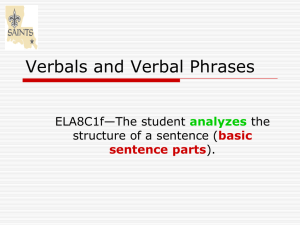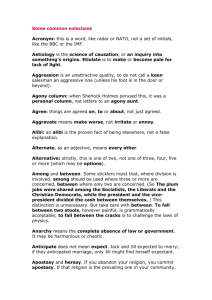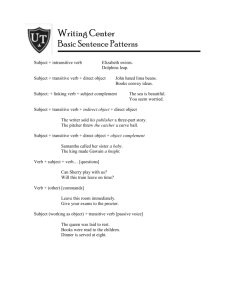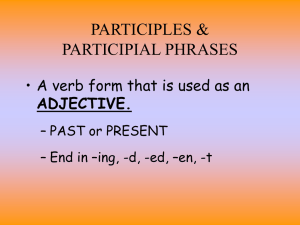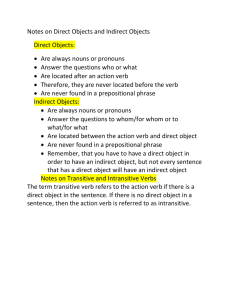On binding, empty ca..
advertisement
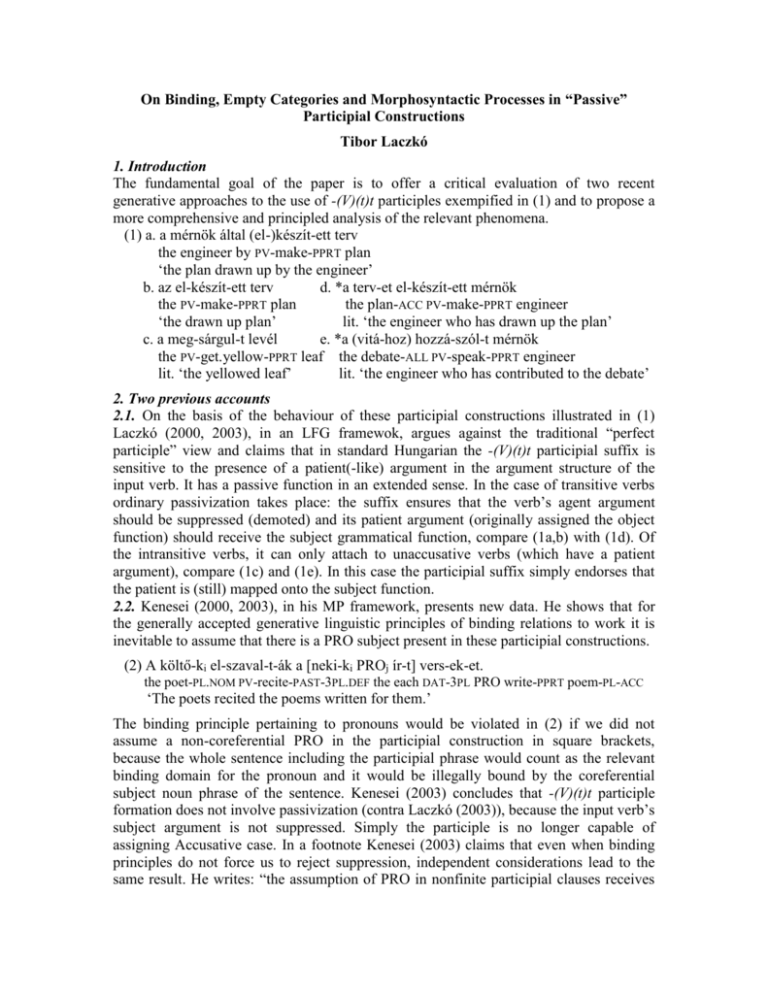
On Binding, Empty Categories and Morphosyntactic Processes in “Passive” Participial Constructions Tibor Laczkó 1. Introduction The fundamental goal of the paper is to offer a critical evaluation of two recent generative approaches to the use of -(V)(t)t participles exempified in (1) and to propose a more comprehensive and principled analysis of the relevant phenomena. (1) a. a mérnök által (el-)készít-ett terv the engineer by PV-make-PPRT plan ‘the plan drawn up by the engineer’ b. az el-készít-ett terv d. *a terv-et el-készít-ett mérnök the PV-make-PPRT plan the plan-ACC PV-make-PPRT engineer ‘the drawn up plan’ lit. ‘the engineer who has drawn up the plan’ c. a meg-sárgul-t levél e. *a (vitá-hoz) hozzá-szól-t mérnök the PV-get.yellow-PPRT leaf the debate-ALL PV-speak-PPRT engineer lit. ‘the yellowed leaf’ lit. ‘the engineer who has contributed to the debate’ 2. Two previous accounts 2.1. On the basis of the behaviour of these participial constructions illustrated in (1) Laczkó (2000, 2003), in an LFG framewok, argues against the traditional “perfect participle” view and claims that in standard Hungarian the -(V)(t)t participial suffix is sensitive to the presence of a patient(-like) argument in the argument structure of the input verb. It has a passive function in an extended sense. In the case of transitive verbs ordinary passivization takes place: the suffix ensures that the verb’s agent argument should be suppressed (demoted) and its patient argument (originally assigned the object function) should receive the subject grammatical function, compare (1a,b) with (1d). Of the intransitive verbs, it can only attach to unaccusative verbs (which have a patient argument), compare (1c) and (1e). In this case the participial suffix simply endorses that the patient is (still) mapped onto the subject function. 2.2. Kenesei (2000, 2003), in his MP framework, presents new data. He shows that for the generally accepted generative linguistic principles of binding relations to work it is inevitable to assume that there is a PRO subject present in these participial constructions. (2) A költő-ki el-szaval-t-ák a [neki-ki PROj ír-t] vers-ek-et. the poet-PL.NOM PV-recite-PAST-3PL.DEF the each DAT-3PL PRO write-PPRT poem-PL-ACC ‘The poets recited the poems written for them.’ The binding principle pertaining to pronouns would be violated in (2) if we did not assume a non-coreferential PRO in the participial construction in square brackets, because the whole sentence including the participial phrase would count as the relevant binding domain for the pronoun and it would be illegally bound by the coreferential subject noun phrase of the sentence. Kenesei (2003) concludes that -(V)(t)t participle formation does not involve passivization (contra Laczkó (2003)), because the input verb’s subject argument is not suppressed. Simply the participle is no longer capable of assigning Accusative case. In a footnote Kenesei (2003) claims that even when binding principles do not force us to reject suppression, independent considerations lead to the same result. He writes: “the assumption of PRO in nonfinite participial clauses receives support from the fact that it has an arbitrary [+human] interpretation,” and he gives the following example. (3) a meg-ugat-ott kisfiú the PV-bark-PPRT boy ‘the boy barked at (by someone/*some dog)’ While I accept the first half of Kenesei’s argumentation with respect to (2) and the need for a PRO subject under such circumstances, it is my conviction that the second half pertaining to (3) is false. There is strong empirical evidence that the covert ‘barker’ argument can have a [–human] reading, therefore, the interpretation of (3) (erroneously) starred by Kenesei is absolutely correct (and a great number of similar examples can be found). From this it follows that, given the relevant and widely received principles of generative grammar, in cases like this the suppression analysis has no alternative. 2. The new proposal This proposal, which can be formulated in either LFG or GB/MP, combines and reconciles the favourable aspects of Laczkó (2003) and Kenesei (2003). Fundamentally, I adopt Laczkó’s analysis, add to it an explicit LFG-style treatment of the case- (and agreement-) encoding potential of finite and non-finite predicates, and modify it on the basis of Kenesei’s binding observation. The crucial assumptions, their consequences and my comments on them are as follows. A)The suffix is sensitive to the presence of a patient argument in the argument structure of the input verb, cf. (1a,b,c) and (3). In this way the unaccusative case and the transitive case can still be treated in uniform manner. I find it a shortcoming of Kenesei’s (2003) approach that it makes no mention of the unaccusative case at all and it seems to me that he could only accommodate this type in his system in a marked way. B) The result of suffixation is that the participial predicate is negatively specified for carrying case/person/number features for its subject and (if the input verb is transitive) for carrying a case feature for its object. From this it follows that neither the input verb’s subject, nor its object (if the verb is transitive) can be overtly realized. Although this ingredient of Laczkó’s (2003) analysis is tacitly assumed, it is not made explicit. In the paper, partially based on my earlier work, I spell out a possible LFG treatment of these empty categories and compare it with Kenesei’s MP solution. C) Suppression is optional in the case of transitive input verbs (in Laczkó (2003), general LFG well-formedness principles block suppression in the intransitive case). For instance, there is no suppression in (2), but there is suppression in (3). This is the radically new component of this proposal, because in Laczkó (2003) “transitive suppression” is obligatory, and in Kenesei (2003) there is no such suppression at all. At the end of the paper I show how the apparatus developed here can be used to analyze agreement-marked -(V)(t)t participial constructions like (4). (4) a mérnök készít-ett-e terv the engineer.NOM make-PPRT-3SG plan ‘the plan drawn up by the engineer’ The following table summarizes the most important generalizations. -(V)(t)t input verb type V … patient … case-encoding ¬(SUBJ CASE), (¬(OBJ CASE)) suppression +/– -(V)(t)t+AGR Vtr … patient … ¬(OBJ CASE) –
